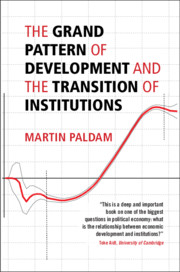Book contents
- The Grand Pattern of Development and the Transition of Institutions
- The Grand Pattern of Development and the Transition of Institutions
- Copyright page
- Contents
- Figures
- Tables
- Preface
- Part I Main Ideas
- Contents
- 1 Introduction
- 2 Some Technical Points
- 3 The Largest Historical Event
- Part II The Transitions of Institutions
- Part III The Grand Transition
- References
- Index
3 - The Largest Historical Event
The End of Soviet Socialism
from Part I - Main Ideas
Published online by Cambridge University Press: 07 August 2021
- The Grand Pattern of Development and the Transition of Institutions
- The Grand Pattern of Development and the Transition of Institutions
- Copyright page
- Contents
- Figures
- Tables
- Preface
- Part I Main Ideas
- Contents
- 1 Introduction
- 2 Some Technical Points
- 3 The Largest Historical Event
- Part II The Transitions of Institutions
- Part III The Grand Transition
- References
- Index
Summary
The biggest historical event in the data since 1960 is the end of Soviet Socialism, which was a very large detour of the political-economic system from the general transition path in ten countries. It led to 28 successor states. The Socialist system suffered from poor economic performance, but the triggering event in the USSR is a set of unique, complex, and unforeseen events, and hence a practically exogenous event in the USSR. It became an exogenous external political event in the other 27 countries. The return of the countries to the long-run transition path has a very wide J-curve. The Muslim/Mena-exception is analyzed. The collapse of Soviet Socialism produced a strong zeitgeist effect in the rest of the world, where Socialism went out of fashion.
Keywords
- Type
- Chapter
- Information
- Publisher: Cambridge University PressPrint publication year: 2021

